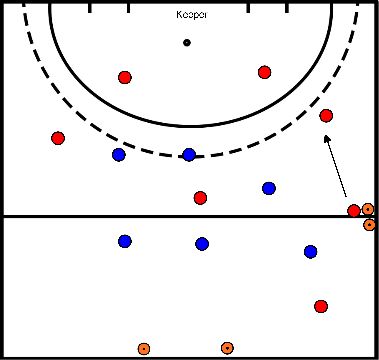Hockey drills
- Technique exercise
- 3 different actions we will refine and train further
- Exercise at A: Two lift actions with at the last one an acceleration to the circle (also practice with backhand lift)
- Exercise at B: Forehand turn them in steps to the left and from there turn them in the other direction and then accelerate towards the circle.
- Exercise at C: Entry exercise to the left and accelerate and the other side along it.
- They walk in the direction of the little v and step in with their left foot and let the ball go that way as well and bring it back and accelerate the other way and pull this acceleration through to the circle and then round it off.
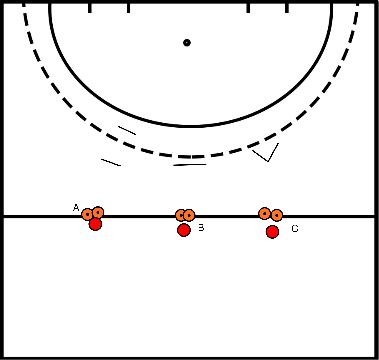
- Further practice with half court press.
- The goal is that they realize what to do when the ball is passed.
- How are we supposed to walk as a front runner.
- Ball starts at A
- The 3 defenders will stand in such a way that the line is closed and so the ball can only be passed to the sides or back out.
- A gives the ball towards B because the line is closed.
- Now comes what the whole exercise is about what the 3 defenders should do now.
- V1 slides so that it is in front of the ball so that the ball cannot be given straight forward.
- V2 stands between the person with the ball and the ball goal line
- V3 which dribbles to the attacker C who comes closer. V3 prevents C from getting the ball and defends on the inside. between the opponent and the goal.
- From here on it is a 3:3
- On the other hand it is exactly the same and discs the defenders the same.
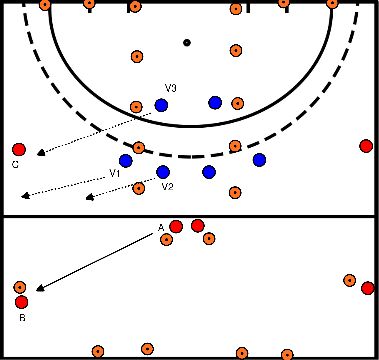
- Exercise expand on both sides
- A gives a push to B
- B takes the ball closed because defender D is in his back.
- B accelerates dribbling with the ball on the stick along the pilons, D runs with B because he doesn't want B to go along.
- D may try to conquer the ball when B has passed the pilons.
- B wants to pass the ball to C. If D intercepts, he passes the ball to C so that the person can continue with the exercise.
- If B gets the ball to C, C will do the same and the defender E will defend. If E picks up the ball, he can finish at the goal.
- How to continue, A goes to the spot of B, B goes to the spot of D, D goes to the spot of C, C goes to the spot of E and E goes to the spot of A.
- Tips for the attackers
- Keep the ball close to you and screen it with your stick
- Pass the ball over the backhand side of your opponent
- Accelerate to make it harder for the defender to stop you
- Tips for the defenders
- Keep your stick on the ground, you can react much faster to what your opponent is doing
- Keep your opponent on the forehand and make sure the line is closed!
- Let the attacker make the mistake and then grab the pass.
- Guide your opponent in the direction where you want him/her to go
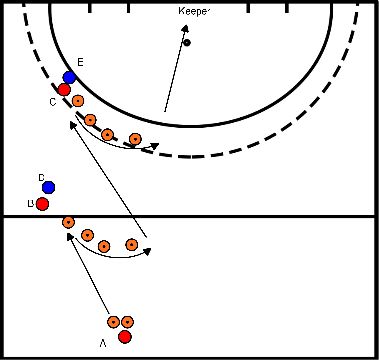
- Exercise expand on both sides.
- A and B start running at the same time,
- A dribbles with the ball on the stick around the pilon.
- B runs in and asks A for the ball.
- A makes eye contact and pushes the ball to B
- B controls the ball closed
- Then dribbles the bars and do two elevator actions over the bars
- Aligns the ball and finishes with a hit on goal.
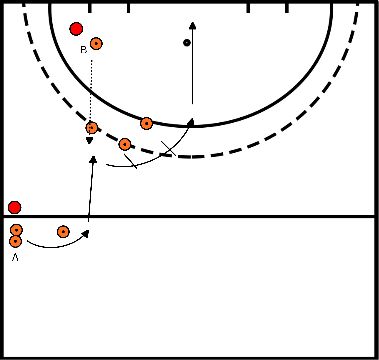
- You let them play a 3:2. Red wants to score the goal and blue wants to intercept and defend the ball.
- When the exercise is running you can add the extra blue defender later on.
- This player will run a tackle back.
- He is allowed to run when the first ball is played.
- Instructions you can give to the attackers
- Ball should always be able to go back,
- Create speed and keep it in your attack,
- someone makes depth so that you keep the field long, pass the ball into the forehand of your fellow player,
- Pass the ball over the opponent's backhand side.
- Questions you can ask the attackers
- What is the purpose of the exercise?
- How can you reach the goal and what do you have to do for it?
- What is the task of which player with which pilon?
- Which pass technique is best to use?
- Instructions you can give to the defenders
- Slow down your opponent by pushing them outward,
- You don't have to take the ball right away but wait for the opponent to make a mistake,
- The line must always be tight
- Questions you can ask the defenders
- What is the purpose of this exercise for you?
- How can you reach the goal and what do you have to do to achieve it?
- What is the most important task you have within this exercise?
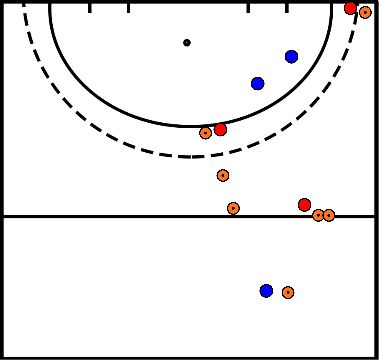
- Expansion to practice with the tip-in.
- Furthermore, it is practiced with the hard and pure pass to each other.
- A pushes the ball to B on the forehand pay attention to the technique (hands apart, left foot in front, force from all over your body, arms moving in the direction you are going).
- B pushes the ball back to A
- A pushes to C, C back to A
- A pushes to D and D back to A
- When B has played the ball back to A he turns around and goes around the pilon and calls to receive the ball.
- A takes the ball from D and gives a hard pass towards E.
- E makes eye contact with the incoming B and gives a directed pass (may be push or pass).
- B takes the ball open, aligns it up and finishes with a hit on goal.
- After shooting, he accelerates around the pilons to run a tip-in ball. F makes eye contact with B and gives a hard targeted pass just as if he is going to score. B causes the ball to change direction.
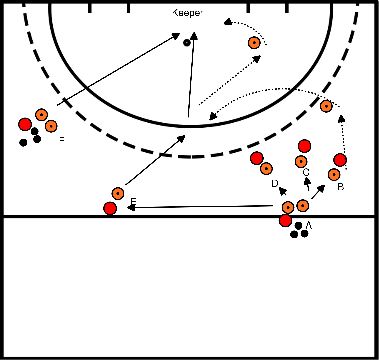
- Players outside the box should replay as often as possible.
- The pass must always pass through the box.
- The players inside the box must try to intercept the ball.
- As soon as the players inside the box have intercepted the ball, they should replay as often as possible inside the box.
- Each time they have replayed 3 times, someone outside the box may enter the box to recapture the ball.
- As soon as they succeed, they will play to someone outside the box and it will start over again, so at least one player must always remain outside the box to be able to play.
- The field can be larger or smaller, there can be more or less players inside and outside the box.
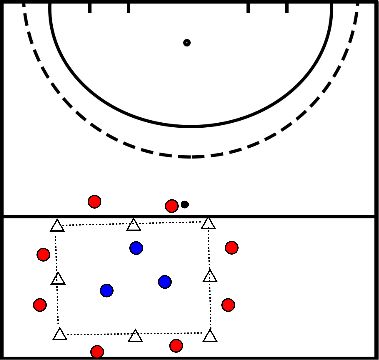
- Player 1 runs with the ball to the white pilon, player 2 runs without the ball to the white pilon.
- Player 2 rounds off on goal (with backhand).
- Player 1 runs around the pilon where player 2 started and runs to the center of the circle.
- As soon as player 1 has played the ball to player 2, player 3 may start. Player 3 plays the ball to player 4.
- Player 4 runs around the white pilon and plays the ball (with backhand) to player 1 who has run into the circle.
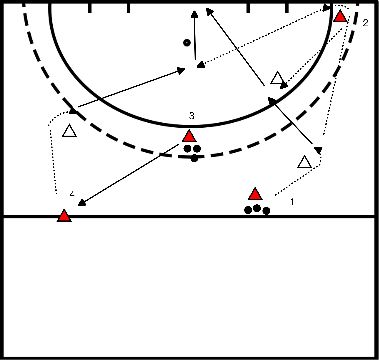
Make 2 teams.
- Both teams have their 'own' course, where they can score points (for example by playing over 5 times in their own course).
- The other team is allowed to conquer the ball in the other box, but not everyone from the other team is allowed to enter the other box.
- The number of players of the other team -1.
- As soon as blue has captured the ball, blue will go to his own square as soon as possible and will play over there as often as possible.
- There may be 3 players of red in the blue box.
- See example: in team red there are 4 players, so 3 players of blue are allowed to enter the red box.
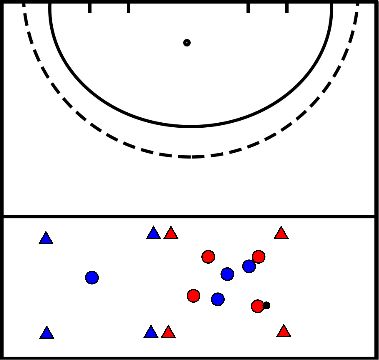
- Goal: to show the player when it is best to pass and when it is best to push.
- In case of a long pass you pass, in case of a short pass you push.
- Player 1 passes (long pass) the ball to player 2
- Player 2 pushes (short pass) the ball to player 3.
- Player 3 passes (long pass) the ball to player 4.
- Player 4 pushes (short pass) the ball to player 5.
- Player 5 passes (long pass) the ball to player 6.
- Player 6 pushes (short pass) the ball to player 7.
- Player 7 runs along the red pilons to the back line and passes (long pass) the ball to player 8, who has entered the circle.
- When explaining the exercise, you can let the player fill in whether it's a long or short pass and what kind of stroke you use, this way they will actively think about it and will apply it earlier in the game.
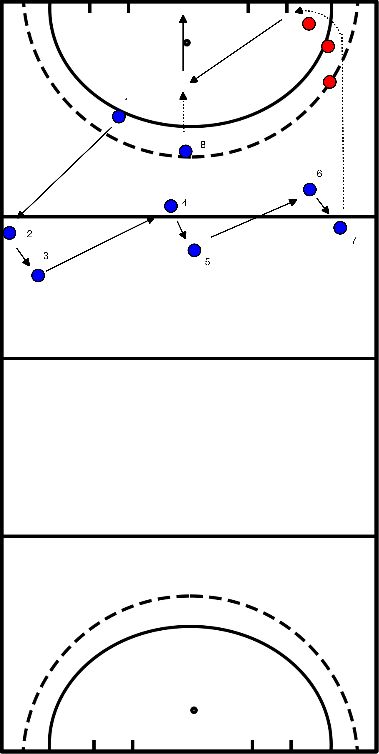
- Make 2 teams.
- From each team place 2 players outside the box opposite each other.
- The ball starts with one of the players outside the box (in the example red).
- As a team you get a point to play from one side to the other, through the players in the box.
- Make the box smaller to make it more difficult or with fewer players.
- Make the box larger to make it easier or with more players.
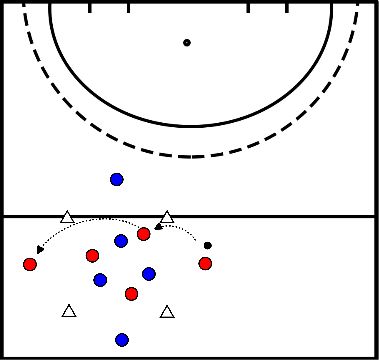
- Practicing putting down a bowl and playing in a cup.
- Ball starts on the sideline and there is no room at the front so the ball has to go back!
- How do you stand in a half-circle?
- We play in a 4 man half-circle and so we stand as it is in the picture below.
- What is the task of the people in the half-circle?
- The left back receives the ball first from the midfielder who takes it out because there is no room in the front.
- It is the task of the left back to have already looked in advance where is the space and where can I go with the ball again.
- Then you have the left center man in the half-circle.
- He takes some steps backwards so he can receive the ball from the back left in a safe place. and must also have looked beforehand how is the game and where can I go with the ball when I'm going to get the ball.
- The right middle man in the half-circle should have an overview of the game and make sure she is playable for the other middle man or even from the left back if there is room for it.
- The right back can stand a bit high or some pockets, he must see the game of the opponent and be able to play on it.
- If high pressure is applied, he has to drop back a bit more to be playable for the people in the bowl behind him.
- If they give less pressure he can stand high to keep the field long and wide and keep playing forward.
- How are we going to build up forward what is the task of the midfielders?
- The task of the midfielders is to offer from the inside out, walk towards the ball and if they don't get the ball you walk away again to create space for your fellow players.
- The other team will put pressure on the players who are playing in the half-circle and will experiment with this.
